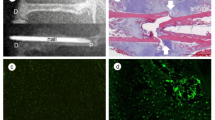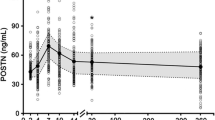Abstract
Background
Diabetes induces bone alterations accompanied by altered cytokine expression patterns. These alterations lead to modified fracture healing, contributing to musculoskeletal fragility in the elderly.
Aims
We evaluated the inflammatory immune response in diabetic patients during fracture healing relative to clinical and radiographic assessments.
Methods
Fifty patients of both sexes with fragility fractures were studied: 30 diabetics (group A, mean age 73.4 ± 11.2 years) and 20 normoglycemic controls (group B, mean age 75.1 ± 16.9 years). Two subgroups comprised those with hip or wrist fragility fractures (25 and 16 patients, respectively). We evaluated serum concentrations of tumor necrosis factor α, interleukins 4 and 8, monocyte chemotactic protein-1 (MCP-1), vascular endothelial growth factor, and epidermal growth factor (EGF) before and at 4 and 8 weeks after surgery. We also determined the Radiographic Union Score for Hips and the Radius Union Scoring System score and applied the Physical Activity Scale for the Elderly test at the same time points. Each patient underwent bone densitometry.
Results
MCP-1 and EGF levels were higher in group A than in group B at 4 weeks after surgery (p > 0.05). Radiographic evaluation showed lower scores in group A (p < 0.05). The main difference between the groups was evident 4 weeks after surgery. Changes in the serum concentrations of chemotactic and angiogenic factors could explain the radiographically proved impaired fracture healing in diabetic patients.
Conclusions
Fragility fracture healing is impaired in diabetic patients. Radiographic and molecular patterns confirmed that the most compromised fracture-healing phase is at 4 weeks after surgery, during callus mineralization.






Similar content being viewed by others
References
Morley JE (2008) Diabetes, sarcopenia, and frailty. Clin Geriatr Med 24:455–469
Ostler JE, Maurya SK, Dials J et al (2014) Effects of insulin resistance on skeletal muscle growth and exercise capacity in type 2 diabetic mouse models. Am J Physiol Endocrinol Metab 306:E592–E605
Guillet C, Boirie Y (2005) Insulin resistance: a contributing factor to age-related muscle mass loss? Diabetes Metab 31:5S20–5S26
Tilling LM, Darawil K, Britton M (2006) Falls as a complication of diabetes mellitus in older people. J Diabetes Complic 20:158–162
Banks WA, Willoughby LM, Thomas DR et al (2007) Insulin resistance syndrome in the elderly: assessment of functional, biochemical, metabolic, and inflammatory status. Diabetes Care 30:2369–2373
Kim KS, Park KS, Kim MJ et al (2014) Type 2 diabetes is associated with low muscle mass in older adults. Geriatr Gerontol Int 14:115–121
Tarantino U, Baldi J, Celi M et al (2013) Osteoporosis and sarcopenia: the connections. Aging Clin Exp Res 25:S93–S95
Cerocchi I, Ghera S, Gasbarra E et al (2013) Fragility fractures: the clinical pathway. Aging Clin Exp Res 25:S43–S45
Saito M, Kida Y, Kato S et al (2014) Diabetes, collagen, and bone quality. Curr Osteoporos Rep 12:181–188
Farr JN, Drake MT, Amin S et al (2013) In vivo assessment of bone quality in postmenopausal women with type 2 diabetes. J Bone Mineral Res 29:787–795
Leslie WD, Rubin MR, Schwartz AV et al (2012) Type 2 diabetes and bone. J Bone Miner Res 27:2231–2237
Celi M, Rao C, Scialdoni A et al (2013) Bone mineral density evaluation in osteoporosis: why yes and why not? Aging Clin Exp Res 25:S47–S49
Giganti MG, Tresoldi I, Masuelli L et al (2014) Fracture healing: from basic science to role of nutrition. Front Biosci (Landmark Ed) 19:1162–1175
Giganti MG, Liuni F, Celi M et al (2012) Changes in serum levels of TNF-alpha, IL-6, OPG, RANKL and their correlation with radiographic and clinical assessment in fragility fractures and high energy fractures. J Biol Regul Homeost Agents 26:671–680
Santana RB, Xu L, Chase HB et al (2003) A role for advanced glycation end products in diminished bone healing in type 1 diabetes. Diabetes 52:1502–1510
Chen QQ, Wang WM (2014) Expression of FGF-2 and IGF-1 in diabetic rats with fracture. Asian Pac J Trop Med 7:71–75
Follak N, Klöting I, Merk H (2005) Influence of diabetic metabolic state on fracture healing in spontaneously diabetic rats. Diabetes Metab Res Rev 21:288–296
Chaudhary SB, Liporace FA, Gandhi A et al (2008) Complications of ankle fracture in patients with diabetes. J Am Acad Orthop Surg 16:159–170
Roszer T (2011) Inflammation as signal of death or life signal in diabetic fracture healing. Inflamm Res 60:3–10
Macey LR, Kana SM, Jingushi S et al (1989) Defects of early fracture-healing in experimental diabetes. J Bone Jt Surg Am 71:722–733
Shimoaka T, Kamekura S, Chikuda H et al (2004) Impairment of bone healing by insulin receptor substrate-1 deficiency. J Biol Chem 279:15314–15322
Lu H, Kraut D, Gerstenfeld LC et al (2003) Diabetes interferes with the bone formation by affecting the expression of transcription factors that regulate osteoblast differentiation. Endocrinology 144:346–352
Tarantino U, Saturnino L, Scialdoni A et al (2013) Fracture healing in elderly patients: new challenges for antiosteoporotic drugs. Aging Clin Exp Res 25:S105–S108
Alblowi J, Kayal RA, Siqueira M et al (2009) High levels of tumor necrosis factor-alpha contribute to accelerated loss of cartilage in diabetic fracture healing. Am J Pathol 175:1574–1585
Graves DT, Kayal RA (2008) Diabetic complications and dysregulated innate immunity. Front Biosci 13:1227–1239
Jiang XQ, Liu HA, Chen Q et al (2012) Experimental study on the levels of related cytokinees and behavior changes during the course of fracture healing in streptozotocin-induced diabetic rats. Chin J Behav Med Brain Sci 21:979–981
McLaren M, Elhadd TA, Greene SA et al (1999) Elevated plasma vascular endothelial cell growth factor and thrombomodulin in juvenile diabetic patients. Clin Appl Thromb Hemost 5:21–24
Huang H, Jing G, Wang JJ et al (2015) ATF4 is a novel regulator of MCP-1 in microvascular endothelial cells. J Inflamm (Lond) 12:2015
Köttstorfer J, Kaiser G, Thomas A et al (2013) The influence of non-osteogenic factors on the expression of M-CSF and VEGF during fracture healing. Injury 44:930–934
Kayal RA, Alblowi J, McKenzie E et al (2009) Diabetes causes the accelerated loss of cartilage during fracture repair which is reversed by insulin treatment. Bone 44:357–363
Gerber H, Vu T, Ryan A et al (1999) VEGF couples hypertrophic cartilage remodelling, ossification and angiogenesis during endochondral bone formation. Nat Med 5:623–628
Carlevaro MF, Cermelli S, Cancedda R et al (2000) Vascular endothelial growth factor (VEGF) in cartilage neovascularization and chondrocyte differentiation: autoparacrine role during endochondral bone formation. J Cell Sci 113:59–69
Kayal RA, Tsatsas D, Bauer MA et al (2007) Diminished bone formation during diabetic fracture healing is related to the premature resorption of cartilagine associated with increased osteoclast activity. J Bone Miner Res 22:560–568
Chiavaras MM, Bains S, Choudur H et al (2013) The Radiographic Union Score for Hip (RUSH): the use of a checklist to evaluate hip fracture healing improves agreement between radiologists and orthopedic surgeons. Skelet Radiol 42:1079–1088
Patel SP, Anthony SG, Zurakowski D et al (2014) Radiographic scoring system to evaluate union of distal radius fractures. J Hand Surg Am 39:1471–1479
Washburn RA, Smith KW, Jette AM et al (1993) The Physical Activity Scale for the Elderly (PASE): development and evaluation. J Clin Epidemiol 46:153–162
Alblowi J, Tian C, Siqueira MF et al (2013) Chemokine expression is upregulated in chondrocytes in diabetic fracture healing. Bone 53:294–300
Ishimi Y, Miyaura C, Jin CH et al (1990) IL-6 is produced by osteoblasts and induces bone resorption. J Immunol 145:3297–3303
Jilka RL, Hangoc G, Girasole G et al (1992) Increased osteoclast development after estrogen loss: mediation by IL-6. Science 257:88–91
Thomson BM, Mundy GR, Chambers TJ (1987) Tumor necrosis factor alpha and beta induce osteoblastic cells to stimulate osteoclastic bone resorption. J Immunol 138:775–779
Devlin RD, Reddy SV, Savino R et al (1998) Interleukin-1 and tumor necrosis factor stimulate the formation of human osteoclast-like cells in vitro. J Bone Miner Res 13:393–399
Matsushima K, Larsen CG, DuBois GC et al (1989) Purification and characterisation of a novel monocyte chemotactic and activating factor produced by a human myelomonocytic cell line. J Exp Med 169:1485–1490
Wu AC, Morrison NA, Kelly WL et al (2013) MCP-1 expression is specifically regulated during activation of skeletal repair and remodeling. Calcif Tissue Int 92:566–575
Chim SM, Kuek V, Chow ST et al (2015) EGFL7 is expressed in bone microenvironment and promotes angiogenesis via ERK, STAT3 and integrin signaling cascades. J Cell Physiol 230:82–94
Author information
Authors and Affiliations
Corresponding author
Ethics declarations
Conflict of interest
On behalf of all authors, the corresponding author states that there is no conflict of interest.
Ethical approval
All procedures performed in studies involving human participants were in accordance with the ethical standards of the institutional and/or national research committee and with the 1964 Helsinki declaration and its later amendments or comparable ethical standards.
Informed consent
Informed consent was obtained from all individual participants included in the study.
Rights and permissions
About this article
Cite this article
Liuni, F.M., Rugiero, C., Feola, M. et al. Impaired healing of fragility fractures in type 2 diabetes: clinical and radiographic assessments and serum cytokine levels. Aging Clin Exp Res 27 (Suppl 1), 37–44 (2015). https://doi.org/10.1007/s40520-015-0422-4
Received:
Accepted:
Published:
Issue Date:
DOI: https://doi.org/10.1007/s40520-015-0422-4




